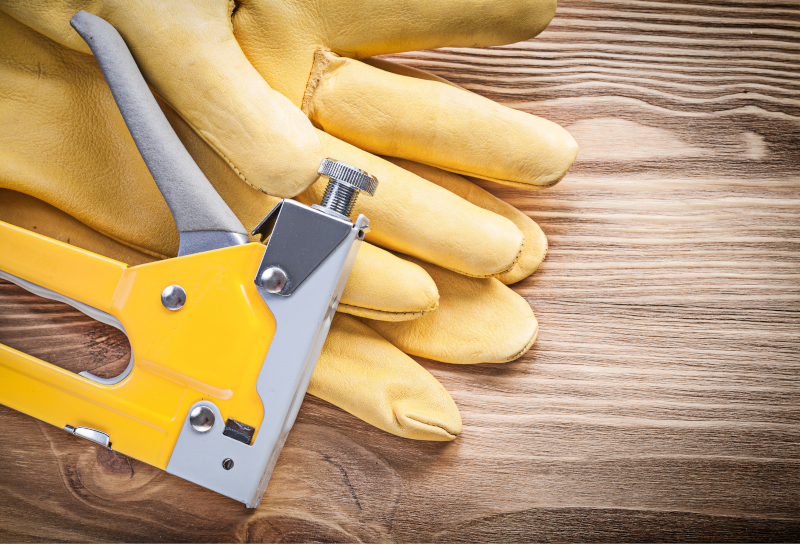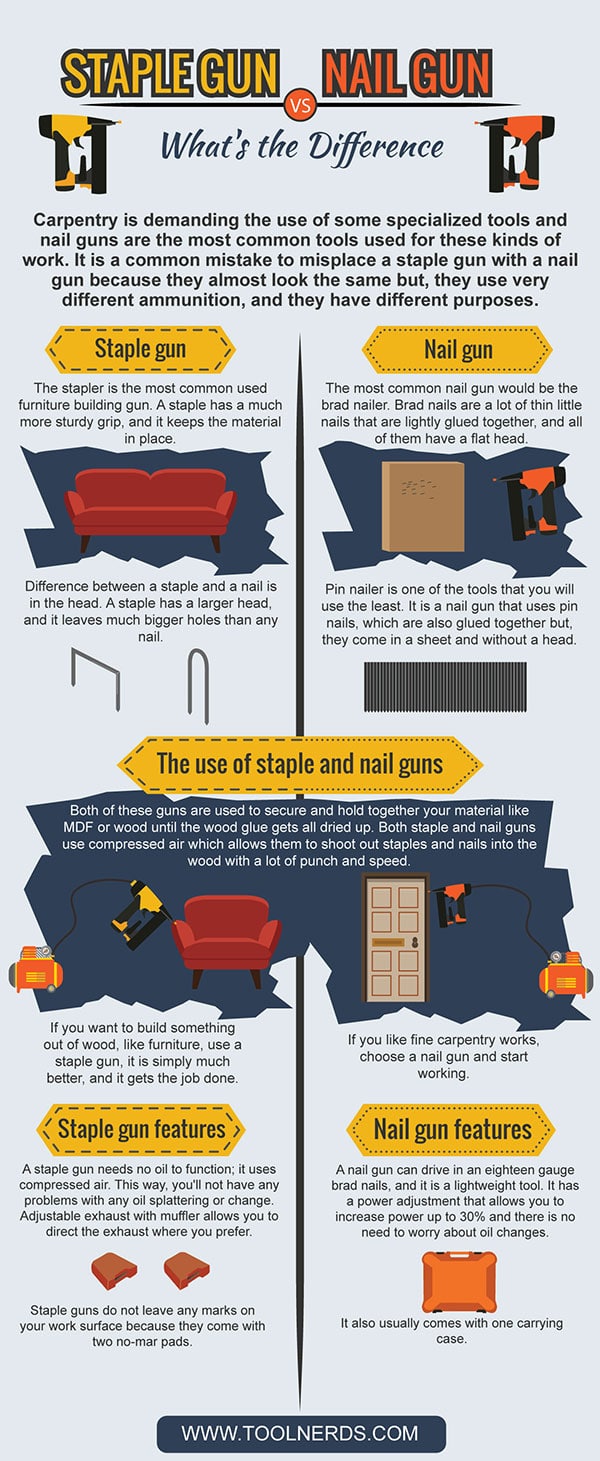Looking for alternatives to a nail gun? Sometimes, it’s handy to have options in your toolkit. Whether you’re a DIY enthusiast or a professional carpenter, there are other tools you can use instead of relying solely on a nail gun.
But why would you explore alternatives? Well, maybe you’re working on a delicate project that requires precision or handling materials that don’t work well with nails. Whatever the reason, let’s dive into some fantastic alternatives to the trusty nail gun that you can use for your next project.
From traditional tools like hammers and screws to innovative options like adhesive and pocket hole jigs, we’ll explore a range of alternatives that can get the job done effectively – no nail gun required. So, grab your tools and let’s discover some exciting ways to bring your projects to life!

Exploring Alternatives: What Can You Use Instead of a Nail Gun?
When it comes to carpentry and DIY projects, a nail gun is often seen as a go-to tool for fastening materials together. However, there are situations where a nail gun might not be available or suitable for the task at hand. In this article, we will explore various alternatives that you can use instead of a nail gun. Whether you’re looking for a solution that doesn’t require power tools or you simply want to try out different methods, you’ll find plenty of options to consider.
Hand Tools: Traditional Alternatives
1. Hammer and Nails: The hammer and nails combination is the most basic and traditional way of fastening materials together. By positioning the nail on the desired spot and striking it with the hammer, you can achieve a secure connection. While it may take more time and effort compared to a nail gun, this method gives you precise control over each individual nail.
2. Screwdriver and Screws: If you’re working with thicker materials or need a stronger connection, using screws instead of nails might be a better option. With a screwdriver and screws, you can create a secure bond that can withstand greater forces. The advantage of using screws is that they can be easily removed and adjusted if needed.
3. Clamps: Clamps are an excellent alternative when you need to hold materials together temporarily. They can provide a strong grip and hold materials securely in place while you work on other aspects of your project. Clamps are particularly useful for gluing or laminating materials.
Adhesive-Based Alternatives
1. Construction Adhesive: For projects that require a permanent bond, construction adhesive can be a reliable alternative to a nail gun. Available in various formulations for specific applications, construction adhesive provides a strong adhesive bond between materials such as wood, metal, or plastic. It’s important to follow the manufacturer’s instructions and ensure proper curing time for the adhesive to reach its maximum strength.
2. Double-sided Tape: Double-sided tape is a quick and easy alternative for temporary or lightweight applications. It can be used to attach lightweight materials together or temporarily mount objects. Double-sided tape is ideal for situations where you want to avoid damaging the surface of the materials or when you need a temporary solution that can be easily removed without leaving residue.
3. Tongue and Groove: Tongue and groove joints are commonly used in woodworking to connect wooden boards together. This method involves creating a groove on one side of the board and a corresponding tongue on the other side. When the boards are fitted together, the interlocking tongue and groove create a strong joint without the need for additional fasteners.
Advanced Alternatives: Power Tools
1. Impact Driver: An impact driver is a versatile power tool that can be used as an alternative to a nail gun. It uses rotational force and torque to drive screws and fasteners into materials. With adjustable settings, you can control the depth and speed of the fastening process. An impact driver can handle a wide range of tasks, from simple fastening to more complex projects.
2. Staple Gun: A staple gun is a handy tool when you need to attach fabric, upholstery, or thin materials together with staples. It’s commonly used in upholstery projects, carpet installation, and other similar applications. Some staple guns also have the ability to drive brad nails, making them a versatile option for various projects.
3. Pneumatic Nailers: While we’re discussing alternatives to a nail gun, it’s worth mentioning pneumatic nailers. Pneumatic nailers use compressed air to drive nails into materials quickly and efficiently. They come in various types, including framing nailers, finish nailers, and brad nailers, each suitable for specific tasks.
Exploring different alternatives to a nail gun allows you to have more options when it comes to your projects. Whether you prefer the traditional approach, adhesive-based solutions, or using power tools, there’s a method that will suit your needs. It’s important to consider factors such as the materials you’re working with, the type of connection required, and the specific project at hand. Choose the alternative that best fits your requirements, and get creative with your woodworking and DIY endeavors!
Key Takeaways: What Can You Use Instead of a Nail Gun?
When you don’t have a nail gun, here are some alternatives you can use:
- Hammer and nails: A traditional and reliable method for securing materials together.
- Screw gun: Ideal for joining materials that require a stronger bond.
- Adhesive: Using glue or adhesive can be a viable option for certain applications.
- Bruce: Bruce is a manual tool that shoots small nails into materials.
- Staple gun: Suitable for attaching fabrics or thin materials to surfaces.
Remember, each alternative has its own pros and cons, so consider your project’s requirements before choosing the best option.
Frequently Asked Questions
Welcome to our Frequently Asked Questions section where we will answer your queries about alternative options to nail guns! If you’re looking for alternative tools or methods to complete your projects without a nail gun, you’re in the right place. Read on to find out more!
1. What are some alternatives to using a nail gun?
Instead of a nail gun, you can use a hammer and nails to complete your projects. This classic method allows for precise control over nail placement and can be useful for smaller projects or when working with delicate materials. Another option is using adhesive, such as construction adhesive, which provides a strong bond. Additionally, there are alternative tools like a brad nailer or finish nailer that use smaller nails and can be operated manually or with a hammer.
It’s worth noting that for larger projects or when working with harder materials, a nail gun can save time and effort. However, these alternatives can be great options depending on your specific needs!
2. Can I use screws instead of nails?
Absolutely! Screws can be a reliable substitute for nails and offer several advantages. They provide a stronger and more secure hold, making them ideal for projects that require extra stability. When using screws, it’s important to select the right size and type for your project. Additionally, pre-drilling pilot holes can help prevent wood from splitting or cracking when inserting the screws.
Keep in mind that screws may not be suitable for every project, especially when aesthetics are a consideration as they are more visible compared to nails. It’s always a good idea to assess the specific requirements of your project before deciding on screws as an alternative to a nail gun.
3. Are there any other tools that can replace a nail gun?
Yes, there are a few other tools that can be used instead of a nail gun. One option is a staple gun, which is especially useful for upholstery projects or attaching fabric to surfaces. Another tool is a hand drill with screws or dowels, often used in woodworking. Additionally, a power drill with specific attachments can be used to drive screws or nails into various materials.
Each of these tools has its own advantages and limitations, so it’s important to consider the specific requirements of your project before choosing an alternative to a nail gun.
4. Can I use a glue gun instead of a nail gun?
While a glue gun can be used as an alternative to a nail gun in certain situations, it has limitations. Glue guns can provide a temporary bond and are great for lightweight crafts and DIY projects. They can also be useful when combining other joining methods, like screws or staples. However, they may not offer the same level of strength and durability as nails or screws, especially for load-bearing structures or heavy-duty projects.
When considering a glue gun as an alternative, it’s important to assess the specific requirements and materials of your project to determine if it’s a suitable option.
5. What should I consider when choosing an alternative to a nail gun?
When choosing an alternative to a nail gun, several factors should be considered. First, identify the specific needs of your project – the type of material, size, and load-bearing requirements. Consider the desired strength and durability of the connection. Additionally, think about the tools and materials you have available, as well as your own skill level.
By taking these factors into account, you can make an informed decision regarding the best alternative to use for your project, whether it’s a hammer and nails, screws, adhesive, or other tools mentioned above.

DON’T USE TRIM NAILS! Try These Instead…(TRIM HEAD SCREWS / TRIM SCREWS–Easy Woodworking Screws)
Summary
If you don’t have a nail gun, don’t worry! There are other tools you can use instead.
One option is a hammer and nails. It may take a bit longer, but it gets the job done. Another option is a screwdriver and screws. This works well for certain materials. You can also try adhesive or glue, which can be great for lightweight projects. And if all else fails, there’s always duct tape! Just remember to choose the right tool for the job and be safe while working.
